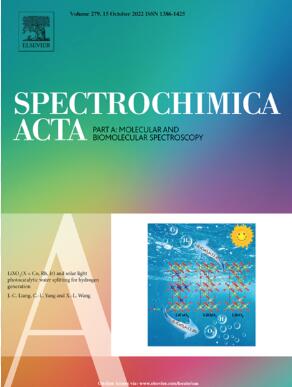Carbon dot-based molecularly imprinted polymer fluorescent sensor for the detection of propranolol in plasma
IF 4.6
2区 化学
Q1 SPECTROSCOPY
Spectrochimica Acta Part A: Molecular and Biomolecular Spectroscopy
Pub Date : 2024-12-14
DOI:10.1016/j.saa.2024.125590
引用次数: 0
Abstract
Propranolol, a medication used to treat cardiovascular diseases, can be harmful when overdosed and hazardous to ecosystems if released into the environment. Here, a new molecularly imprinted fluorescent sensor was developed from carbon dots through a sol–gel method. Carbon dots served as both the fluorescent signal and the carrier, with propranolol as the template molecule and 3-aminopropyltriethoxysilane as the functional monomer to be grafted on carbon dots’ surface. A novel detection method was established for the efficient, rapid, and cost-effective detection of propranolol in human plasma through quantitative analysis by using a fluorescence spectrophotometer and an ultraviolet spectrophotometer. Under the optimal conditions, the detection range of 0.5–4 mg L−1, the detection limit of 0.092 mg L−1, the imprinting factor of 2.42, and the detection response time of 2 min were achieved. The prepared carbon dot-based molecularly imprinted fluorescent sensor was proved to have a wide accurate linear range, low detection limit, and very short response time, and can detect lower analyte concentrations with higher detection accuracy.

碳点基分子印迹聚合物荧光传感器检测血浆中心得安。
普萘洛尔是一种用于治疗心血管疾病的药物,服用过量会对人体有害,如果释放到环境中会对生态系统造成危害。本文采用溶胶-凝胶法制备了碳点分子印迹荧光传感器。碳点作为荧光信号和载体,以心得安为模板分子,以3-氨基丙基三乙氧基硅烷为功能单体接枝在碳点表面。采用荧光分光光度计和紫外分光光度计对人血浆中心得安进行定量分析,建立了一种高效、快速、经济的检测方法。在最佳条件下,检测范围为0.5 ~ 4 mg L-1,检出限为0.092 mg L-1,印迹因子为2.42,检测响应时间为2 min。实验证明,所制备的碳点分子印迹荧光传感器线性范围宽、检测限低、响应时间短,能够检测较低浓度的分析物,检测精度较高。
本文章由计算机程序翻译,如有差异,请以英文原文为准。
求助全文
约1分钟内获得全文
求助全文
来源期刊
CiteScore
8.40
自引率
11.40%
发文量
1364
审稿时长
40 days
期刊介绍:
Spectrochimica Acta, Part A: Molecular and Biomolecular Spectroscopy (SAA) is an interdisciplinary journal which spans from basic to applied aspects of optical spectroscopy in chemistry, medicine, biology, and materials science.
The journal publishes original scientific papers that feature high-quality spectroscopic data and analysis. From the broad range of optical spectroscopies, the emphasis is on electronic, vibrational or rotational spectra of molecules, rather than on spectroscopy based on magnetic moments.
Criteria for publication in SAA are novelty, uniqueness, and outstanding quality. Routine applications of spectroscopic techniques and computational methods are not appropriate.
Topics of particular interest of Spectrochimica Acta Part A include, but are not limited to:
Spectroscopy and dynamics of bioanalytical, biomedical, environmental, and atmospheric sciences,
Novel experimental techniques or instrumentation for molecular spectroscopy,
Novel theoretical and computational methods,
Novel applications in photochemistry and photobiology,
Novel interpretational approaches as well as advances in data analysis based on electronic or vibrational spectroscopy.

 求助内容:
求助内容: 应助结果提醒方式:
应助结果提醒方式:


